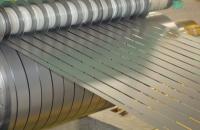
Silicon steel sheets are the primary material for transformer cores, known for their excellent magnetic properties and low loss characteristics. By reducing hysteresis and eddy current losses, silicon steel significantly enhances transformer efficiency. It is widely used in power systems for distribution transformers, generators, and electric motors.
The applications of silicon steel sheets are mainly reflected in the following aspects: first, they achieve high magnetic permeability under low magnetic fields, reducing magnetizing current and improving transformer efficiency. Second, silicon steel has high electrical resistivity, which limits eddy currents in the core, thereby lowering energy losses. Lastly, high-quality silicon steel sheets can withstand high-frequency operating conditions, meeting the demands of modern power equipment.
Based on their grain orientation, silicon steel sheets are classified into two types:Grain-Oriented Silicon Steel,This type is processed to align the grain structure in a specific direction, resulting in superior magnetic properties along that direction. Grain-oriented silicon steel is primarily used in the main magnetic circuits of transformer cores. It features low core loss and high magnetic flux density, making it an ideal material for energy-efficient transformers;Non-oriented silicon steel has uniformly distributed grains, making it suitable for magnetic fields in all directions. It is commonly used in motors, generators, and small transformers. While its core loss and magnetic flux performance are slightly inferior to grain-oriented silicon steel, it is more cost-effective to produce.

With the growing demand for energy efficiency, silicon steel technology continues to evolve. Innovations such as ultra-low-loss silicon steel and high-magnetic-flux silicon steel are providing more options for manufacturing energy-efficient transformers. The proper application and classification of silicon steel sheets are critical to the performance and lifespan of transformers, playing a key role in power equipment design.
Stainless Steel Sheets Curtain Wall Design is More Advanced!
2022-01-14Silicon steel sheet: the core and performance cornerstone of motor magnetic circuit
2025-10-27The mysteries of stainless steel: Types, properties and applications
2024-06-22321 and 304 stainless steel corrosion resistance and high temperature performance
2024-07-06How will the next generation of motor technology revolutionize materials and architecture?
2024-06-26Common stainless steel 316 and 316L difference
2024-05-06






